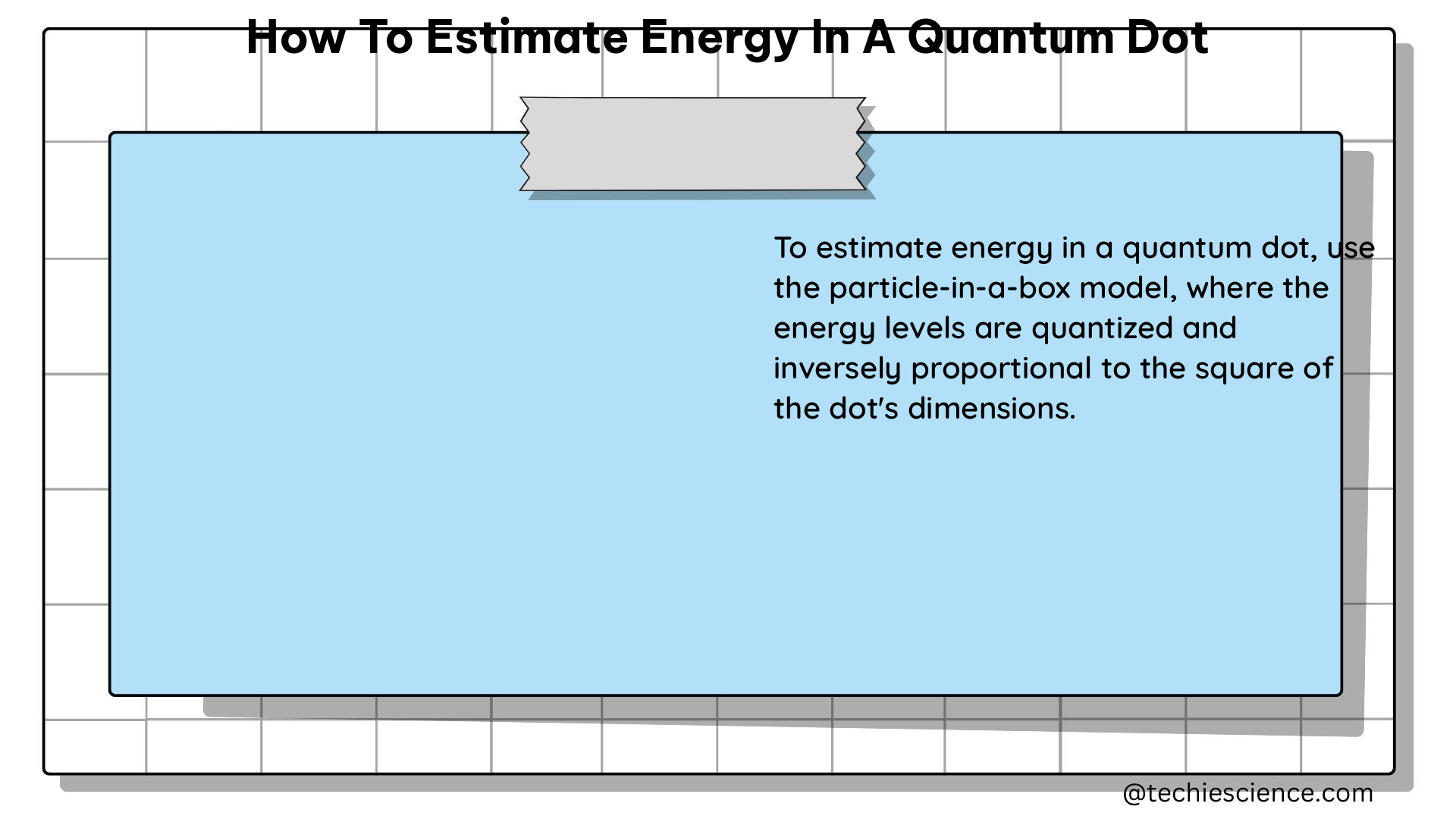Summary
Estimating the energy in a quantum dot involves understanding the size-dependent energy gap, the charging energy, and the quantum level spacing. This comprehensive guide provides detailed information on the theoretical models, experimental techniques, and quantifiable data points that can be used to accurately estimate the energy in a quantum dot.
Size-Dependent Energy Gap

The energy gap in a quantum dot is strongly dependent on the size of the nanoparticle due to the quantum confinement effect. As the size of the quantum dot decreases, the energy gap increases. This relationship can be described by the following equation:
$E_g = E_g^{bulk} + \frac{\hbar^2\pi^2}{2m^*R^2}$
Where:
– $E_g$ is the energy gap of the quantum dot
– $E_g^{bulk}$ is the energy gap of the bulk material
– $\hbar$ is the reduced Planck constant
– $m^*$ is the effective mass of the charge carrier
– $R$ is the radius of the quantum dot
Using this equation, we can estimate the energy gap of a quantum dot given its size. For example, a CdSe quantum dot with a radius of 2 nm has an energy gap of approximately 2.4 eV, while a CdSe quantum dot with a radius of 4 nm has an energy gap of around 1.9 eV.
Experimental Measurement of Size-Dependent Energy Gap
Valence electron energy-loss spectroscopy (VEELS) is a powerful technique that can be used to directly measure the size-dependent energy gap of individual quantum dots. In a study by Erni and Browning, the energy gap of individual CdSe quantum dots was measured using VEELS, and the results showed a clear size-dependent increase in the energy gap as the particle size decreased.
Charging Energy
The charging energy of a quantum dot is the energy required to add an additional electron to the dot. This energy can be estimated using a capacitance model, where the total capacitance of the dot is the sum of the capacitances across the barriers (Cl and Cr) and the capacitance between the dot and the gate (Cg).
The electrochemical potential for N electrons on the dot can be calculated as:
$\mu_{\text{dot}}(N) = E_N + \frac{(N – N_0)e}{C} – \frac{e}{2C} – \frac{eC_g}{C}V_g$
Where:
– $E_N$ is the energy of the Nth electron
– $N_0$ is the number of electrons at which the dot is neutral
– $e$ is the elementary charge
– $C$ is the total capacitance of the dot
– $V_g$ is the gate voltage
By measuring the capacitances and the gate voltage, we can estimate the charging energy of the quantum dot.
Quantum Level Spacing
The quantum level spacing in a quantum dot is the energy difference between the discrete energy levels within the dot. This spacing can be estimated from the dimensions of the dot and the Fermi energy of the material.
For a 2D quantum dot with a constant Fermi energy $E_F$, the charging energy $E_C$ varies with the number of electrons $N$ as:
$E_C \sim \frac{E_F}{\sqrt{N}}$
And the level spacing $\Delta E$ varies as:
$\Delta E \sim \frac{E_F}{N}$
By measuring the charging energy and the level spacing, we can estimate the Fermi energy and the dimensions of the quantum dot.
Experimental Measurement of Quantum Dot Size
Pulsed field gradient nuclear magnetic resonance (PFG-NMR) is a technique that can be used to estimate the size of quantum dots, such as PbS quantum dots. In a study by the Journal of Chemical Education, PbS quantum dots of various sizes were synthesized, and their sizes were measured using PFG-NMR. The results were then correlated with optical measurements, providing a reliable method for estimating the size of quantum dots.
Transport Signatures
The energy levels and charging energy of a quantum dot can also be probed through transport measurements. For example, in an Andreev molecule in a quantum dot, transport measurements using a sufficiently large bias voltage can determine energy gaps above the superconducting gap.
Conclusion
Estimating the energy in a quantum dot is a complex task that requires a deep understanding of the underlying physics and the use of various experimental techniques. This comprehensive guide has provided detailed information on the theoretical models, experimental methods, and quantifiable data points that can be used to accurately estimate the energy in a quantum dot. By applying these principles, researchers and physicists can gain valuable insights into the properties of quantum dots and their potential applications in various fields of science and technology.
References
- Erni, R., & Browning, N. D. (2007). Quantification of the size-dependent energy gap of individual CdSe quantum dots by valence electron energy-loss spectroscopy. Ultramicroscopy, 107(9), 761–769. doi: 10.1016/j.ultramic.2007.02.004
- Transport signatures of an Andreev molecule in a quantum dot. (n.d.). Beilstein Journal of Nanotechnology. Retrieved from https://www.beilstein-journals.org/bjnano/articles/10/36
- Data Needs and Challenges of Quantum Dot Devices Automation. (2023). arXiv. Retrieved from https://arxiv.org/html/2312.14322v1
- Electron Transport in Quantum Dots. (n.d.). Retrieved from https://courses.physics.illinois.edu/phys598MN/sp2015/readings/Dots_Review.pdf
- Estimating Quantum Dot Size with Pulsed Field Gradient NMR. (2023). Journal of Chemical Education. doi: 10.1021/acs.jchemed.3c00155

The lambdageeks.com Core SME Team is a group of experienced subject matter experts from diverse scientific and technical fields including Physics, Chemistry, Technology,Electronics & Electrical Engineering, Automotive, Mechanical Engineering. Our team collaborates to create high-quality, well-researched articles on a wide range of science and technology topics for the lambdageeks.com website.
All Our Senior SME are having more than 7 Years of experience in the respective fields . They are either Working Industry Professionals or assocaited With different Universities. Refer Our Authors Page to get to know About our Core SMEs.